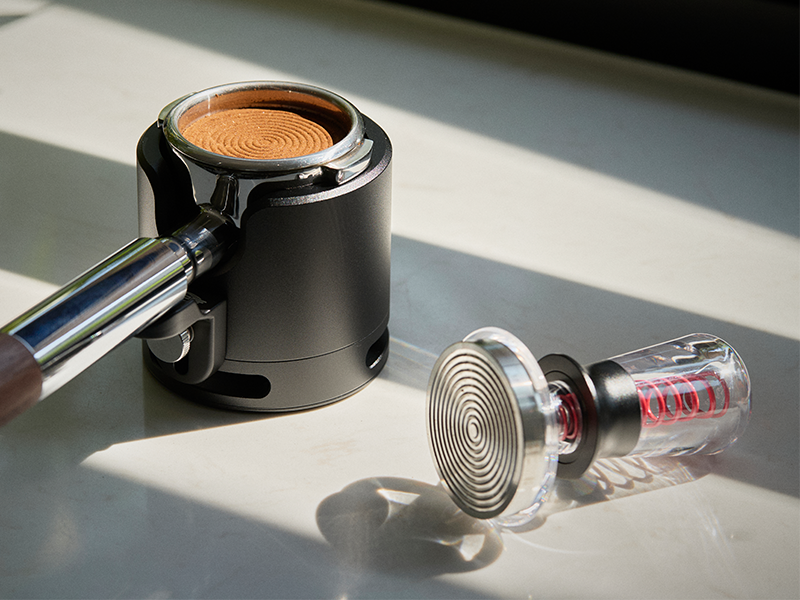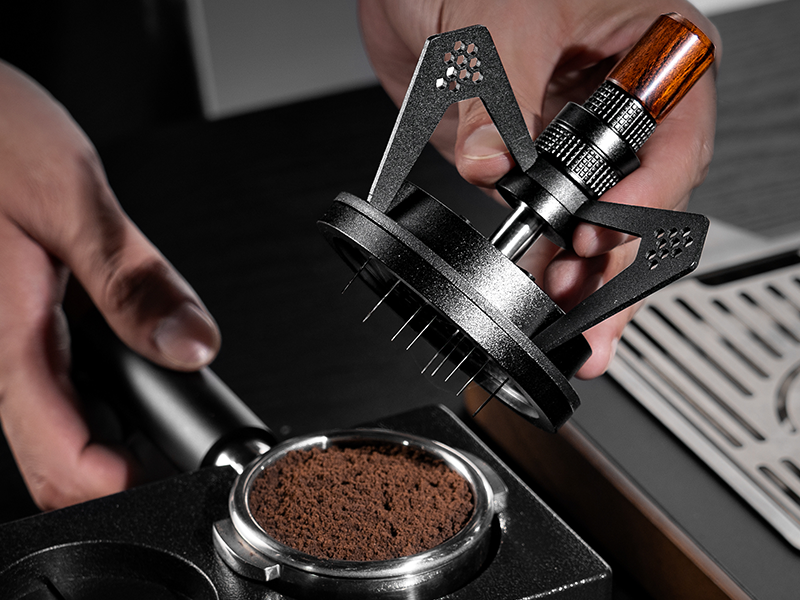Why you need a coffee tamper
The coffee tamper is one of the most crucial tools in the process of making espresso, and it does much more than just compress the powder.
Its core function is to evenly compress the coffee cake, ensuring that the water flows evenly through the powder during high-pressure extraction and avoiding the “channeling effect” (where the water only passes through loose or gaping holes). If the density of the powder is uneven or loose, it will result in an uneven extraction of the coffee ,some areas are over-extracted (bitter) and some are under-extracted (sour).
The presence of a coffee tamper essentially provides a stable and controlled physical base for extraction.
How pressing affects the taste and mouthfeel of coffee
Pressing strength and uniformity:
Too much strength: too dense a powder cake, too much resistance to the flow of water, prolonged extraction time, and a tendency to burnt bitterness (over-extraction).
Insufficient strength: the powder is loose, the water flow is too fast, the sour taste is prominent, the flavor is thin (under-extraction).
Evenly pressed powder (ideal state): the water flow evenly penetrates the powder layer, sweetness, acidity and bitterness are balanced, the flavor level is clear, and the taste of high-quality coffee.
Powder surface flatness:
If the powder is pressed at an angle or with uneven force, the surface of the powder will be uneven, and the water flow will preferentially pass through the areas with less resistance, resulting in uneven extraction. The key to avoiding this problem is to use a coffee tamper that is completely flat on the bottom and keep it pressed vertically at 90 degrees Celsius.
Powder density and extraction rate:
Powder with a consistent density allows for a more even contact area between the water and the coffee powder, improving the effective extraction rate of soluble substances and avoiding stray flavors.
Core factors affecting espresso extraction (related to powder pressing)
Powder pressing strength: the strength of powder pressing directly affects the density of the powder and extraction time. Most people use HengLi coffee tamper to avoid uneven pressing strength, resulting in flavor differences.
Powder uniformity: depends on the pressing technique and tool design (e.g. whether the bottom is flat or not).
Powder bowl size match: the diameter of the coffee tamper must fit perfectly with the inner diameter of the powder bowl (usually the error needs to be less than 0.5mm), otherwise the edges can not be compacted to form the extraction dead space.
The state of coffee powder: freshness, grinding coarseness, and uniformity of the powder (the powder needs to be powdered before pressing to avoid lumps).
How to pick the right coffee coffee tamper
Material:
Stainless steel: durable, antioxidant, corrosion-resistant, easy to clean, moderate weight (recommended for novices).
Aluminum alloy: lightweight, may be deformed by long-term use.
Wooden/resin: beautiful but low practicality, easy to absorb coffee grease and harbor bacteria.
Size match:
Measure the inner diameter of the powder bowl (common household is 58mm, commercial may be 54mm or 58.5mm or other 51MM), choose the matching coffee tamper.
In general, the common size of coffee machine portafilter is 51mm, 54mm, 58mm, for example, all Delonghi coffee machines use 51mm portafilter, so choose 51mm tamper to be compatible with Delonghi coffee machines. 54 breville and sage use special coffee machine portafilter, 8 series. The following breville coffee machines all use 54mm portafilter, so you need to choose 53.3mm coffee tamper for compatibility. Note that breville also has a 58mm portafilter coffee machine, so you should choose a 58.5mm or 58.35mm tamper.
The smaller the error, the better (it is recommended to choose a product that is clearly labeled by the brand to fit the model of the powder bowl).
Bottom design:
Flat bottom: versatile, suitable for beginners, to ensure that the surface of the powder is flat.
Convex bottom: waffle bottom / European arc bottom / some professional coffee tamper designed for threaded bottom, so that the surface of the water and the coffee powder contact area is larger, to enhance the extraction rate.
Advanced Features:
Calibration spring coffee tamper: preset pressure 15/25/30 pounds by spring (IKAPE's coffee tamper) for users who are looking for consistency. Tested with 30 pounds constant force coffee tamper, the extraction rate is almost consistent with different powder amount and consistent extraction time.
Adjustable press base: adjust the depth of the powder by rotating, but requires some experience to be of value.
Practical advice for novices
First practice the technique, then upgrade the tool: initially choose the basic model stainless steel flat-bottomed coffee tamper (58mm), and focus on practicing vertical downward pressure and even force.
Pressing powder strength is not a metaphysics: to the powder surface smooth, no cracks as the standard, rather than blindly pursuing 30 pounds of pressure, you can try to use different strength, you will get a different flavor.
Use with a powder cloth: use a powder cloth (WDT tool and Espresso Distributor) to break up the clumps before pressing the powder for a more even distribution.
Whether you are a coffee novice, a home barista or a professional barista, you can check out IKAPE's tamper for making coffee, because IKAPE provides all series of calibrated coffee tamper, which are professional, practical and easy to use. You can click here for check, IKAPE coffee tamper
The choice and use of the coffee tamper is the basis of espresso, but it is also a key element in determining the upper limit of flavor. Starting with consistency and adaptability and progressing step by step, you can make every cup of coffee a work of art of flavor.






